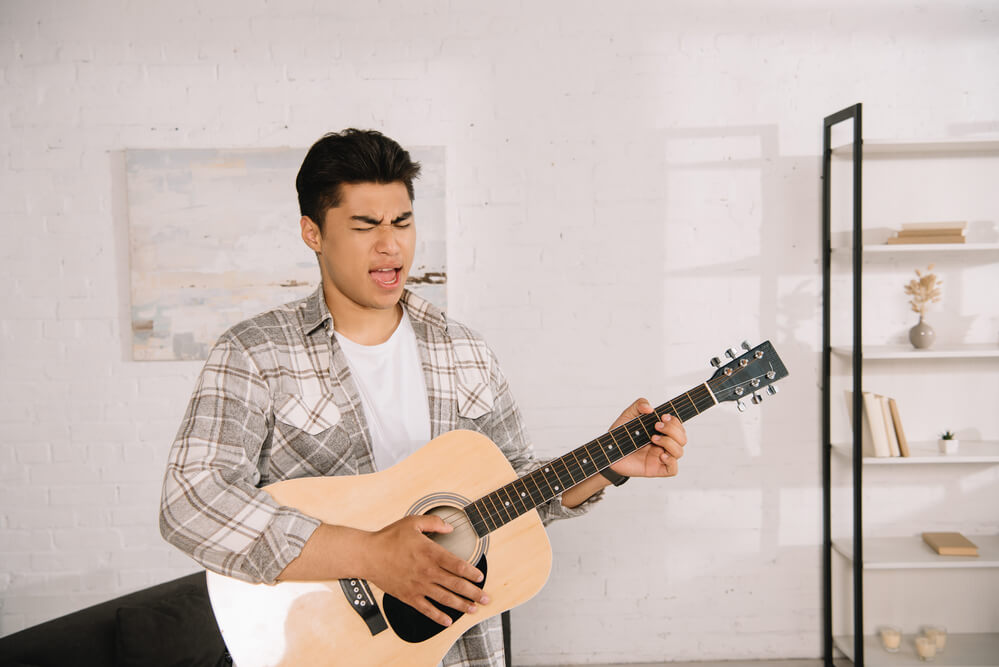Learning to sing and play guitar simultaneously can open up a world of possibilities for musicians. It’s a wonderful skill that can enrich your performance and expand your musical horizons.
As a beginner, the process of mastering both singing and playing guitar at the same time can be quite challenging; how to sing and play guitar at the same time?
with proper guidance and devoted practice, you can become proficient in this art form.
The key to successfully singing and playing guitar lies in understanding the fundamentals of both skills and learning how to synchronize them seamlessly.
It all begins with familiarizing yourself with the guitar and its various components, honing your vocal capabilities, and developing a strong foundation in timing and rhythm.
As you progress, you’ll explore various techniques designed to help you maintain pitch control, develop fingerpicking skills, and improve overall performance.
Key Takeaways
- Become proficient in guitar basics and vocal techniques
- Develop a strong foundation in timing and rhythm synchronization
- Explore ways to improve pitch control, fingerpicking, and performance
How To Sing And Play Guitar At The Same Time
To begin singing and playing the guitar simultaneously, it’s essential to have a good understanding of timings and rhythms. Rhythm is the backbone of music, and it provides a steady beat for us to follow when playing different chords and melodies.
As a guitarist and vocalist, developing your rhythm skills will help you juggle both tasks with confidence and ease.
I recommend starting with basic counting out loud while playing simple chord progressions. This will help you internalize the rhythm and stay in sync.
For example, if the time signature of the song you’re playing is 4/4, count aloud “1-2-3-4,” emphasizing the downbeat on the “1.” This solid foundation of counting will improve your ability to maintain the correct timing as you add vocals.
Next, consider using a metronome to aid your practice sessions. A metronome is a device designed to emit a steady, consistent beat, essential for honing your internal clock.
Set your metronome to the tempo (speed) at which you want your song to be played, and try playing your guitar along with the beat.
The metronome will help you identify areas where your playing may slow down or speed up, allowing you to correct inconsistencies in your timing.
Once you’re comfortable with the guitar portion, it’s time to add your vocal line. Continue to play your guitar with the metronome, but now, try singing along as well.
Focus on matching each syllable or word within your vocal line to its corresponding beat. Initially, you may find it challenging to maintain consistent timing, but with regular practice, your coordination will improve.
Keeping track of both the guitar and vocals’ rhythm will make the application of lyrics to melody more efficient.
Comprehending timings and rhythms is crucial in developing the ability to sing and play the guitar at the same time. Start with basic counting out loud, then practice with a metronome to solidify your internal clock.
Don’t be afraid to make mistakes; consistent practice will lead to improvement.
Guitar Basics for Singing and Playing
As a guitar player and aspiring singer, I’ve found that understanding guitar basics is essential when it comes to singing and playing simultaneously.
To begin, mastering chords and strumming patterns are crucial components of building a solid foundation.
When I first started, I focused on learning basic chords like G, C, D, A, and E, as well as their corresponding minor chords. As I gained confidence and proficiency in forming and transitioning between these chords, I gradually introduced more complex chords into my practice routine.
I have also discovered that strumming patterns greatly influence the rhythm and overall feel of a song. There is a myriad of strumming patterns to explore, but starting with simple patterns like downstrokes or alternate up and down strokes is a great way for any beginner to gain a solid footing.
As I became more comfortable, I started incorporating various strumming techniques such as palm muting, fingerpicking, and percussive hits into my playing.
With my guitar skills improving, I found that the next step was to focus on developing my singing while playing. I began by singing simple melodies or humming along to the chord progressions and strumming patterns I had already learned.
This allowed me to grow more accustomed to the feel of singing and playing simultaneously.
To further hone my abilities, I also dedicated time to listening and singing along with various artists and genres, paying close attention to the nuances and pitch changes in the vocal melodies.
This helped improve my ear and guided me in finding my own voice as a singer.
In my experience, patience and consistent practice have been the keys to success in achieving the goal of singing and playing guitar simultaneously.
By focusing on the fundamentals of guitar playing and gradually developing my singing abilities, I’ve been able to confidently perform my favorite songs and create my own unique sound.
Mastering Guitar Chords
When I first started learning guitar, mastering the chords was a crucial step in order to sing and play simultaneously. It is essential to be confident in chord changes, as seamless transitions will allow you to focus more on singing.
I began by practicing a few chords daily, gradually increasing my chord library. Open chords are excellent for beginners; they provide a solid foundation for playing songs in various genres and are relatively easy to learn.
As I became more comfortable with open chords, I moved on to practicing chord progressions. A chord progression is a series of chords played in a sequence, forming the backbone of a song.
I found that practicing these progressions regularly not only improved my chord changes but also my overall understanding of songs’ structures, making it easier to play and sing at the same time.
To make playing and singing more manageable, it can be helpful to use a capo. The capo allowed me to change the key of a song without having to learn new chords or chord progressions.
This way, I could easily adapt songs to suit my singing range, enabling me to focus on singing while playing the guitar.
During my practice sessions, I would often break down songs into sections and focus on mastering the chords and progressions for each part before moving on. This method helped me build my confidence and improve my muscle memory for various chord changes.
To master guitar chords, it’s essential to practice them regularly, understand and play chord progressions, and use tools like capos to adapt songs to your range.
Building a solid foundation in chords and transitions will be well on your way to singing and playing at the same time.
Learning to Sing while Playing Guitar
When I first started learning to sing and play guitar simultaneously, it was a bit challenging. However, with time and practice, I became more adept at it.
Here’s my process for learning to sing while playing guitar.
To begin, I familiarized myself with the song’s chords and structure on the guitar. I usually practice the fingering and chord transitions until I’m comfortable and can play them smoothly.
This helps me establish a strong foundation for adding my vocals later on.
Next, I concentrate on the vocal melody and lyrics. Singing along with the recording or using a lyrics sheet, I get well acquainted with the song’s melody and phrasing.
I find it important to pay attention to how the vocal lines interact with the guitar playing, as this affects the overall performance.
Once I’m comfortable with the separate elements (guitar playing and singing), I start to slowly combine them. At first, I might only sing a few lines or hum the melody while playing.
Gradually, I added more lyrics and increased the complexity of the vocal lines. During this process, I try to maintain proper vocal techniques, take care of my vocal cords, and avoid strain.
It’s essential to be patient and not rush this step. I give myself time to build muscle memory and coordination, accepting that it might take a while before I can comfortably sing and play guitar together.
In some cases, I find it helpful to use a metronome to maintain a consistent tempo while practicing. The metronome can keep me focused and help me avoid rushing through the song or losing tempo when I add my vocals.
Another critical aspect is staying relaxed as I sing and play guitar. I ensure that my posture is correct and avoid unnecessary tension in my hands, arms, and shoulders.
This not only improves my guitar playing and vocal tones but also reduces the risk of injury due to strain.
Lastly, I practice regularly, devoting time each day to improving my singing and guitar playing simultaneously. Over time, the process becomes more natural, and my confidence grows.
In summary, learning to sing and play guitar at the same time involves mastering each element individually and then slowly combining them. Patience, relaxation, and consistent practice are key to becoming a confident and successful singer and guitarist.
Techniques for Humming and Singing
As a guitarist, I find that learning to simultaneously hum or sing while playing can be challenging.
Nevertheless, there are techniques that can help make the process more manageable. In this section, I will share some tips and tricks to develop this musical skill.
First, I suggest starting by humming the melody of the song. Humming allows me to become familiar with the tune without worrying about articulating every word.
This method gives me an opportunity to get comfortable with keeping time and coordinating my voice with my guitar playing. Once I am confident in humming the melody, I can gradually integrate the lyrics into my performance
Developing Muscle Memory
When I first started learning to sing and play guitar simultaneously, I realized the importance of developing muscle memory. Muscle memory is crucial as it allows me to automatically perform actions with my fretting hand while focusing on singing.
For me to develop muscle memory, consistent practice is key. I spend at least 30 minutes daily practicing both singing and guitar playing. I begin by working on my fingering technique, slowly and deliberately placing my fingers on the frets.
By doing this regularly, my fingers start to remember the positions of the chords and the transitions between them.
While practicing, I make sure both my fretting hand and my picking hand are synchronized and comfortable. This synchronization can be achieved through slow, controlled strumming and focusing on the rhythm.
As my hands become more coordinated, I gradually increase the tempo and add singing to the mix.
In addition to regular practice, I find it helpful to break down the song I’m learning into smaller sections. By mastering each section individually, I can subsequently piece them together with more ease.
This strategy has significantly improved my ability to sing and play guitar at the same time.
Building muscle memory involves a mix of consistent practice, comfortable rhythm, and well-coordinated hand movements. As I progress in my journey, my muscle memory becomes stronger, and the once overwhelming task of singing and playing guitar simultaneously becomes more enjoyable.
Simplifying Song Structure
When I first began learning to sing and play guitar at the same time, I found it helpful to simplify the song structure. By focusing on easy songs, I can build my confidence and gradually develop my skills.
For example, I might choose a song with a straightforward chord progression, such as three chords repeated throughout the song. This kind of structure allows me to focus on both my singing and my guitar playing without feeling overwhelmed.
When I have decided on a song to practice, I make sure it’s well-suited for acoustic guitar. The reason behind this is that acoustic guitar often requires a more rhythmic and simplified approach compared to its electric counterpart.
Simplicity is key when starting out, so I pick a song that compliments my strumming hand.
Before diving headlong into performing the song, it’s essential to have it memorized. I break the song down into smaller sections, such as verses and choruses, and ensure I have the chords, lyrics, and melody firmly memorized.
Splitting the song into manageable chunks allows me to focus on specific elements as I play the guitar and sing.
While playing the song, I pay close attention to the strumming pattern. Simplifying the pattern can make it easier to maintain rhythm and timing while I sing.
Using basic downstrokes and upstrokes, I can become comfortable with the coordination needed to sing and play simultaneously.
It’s important to remember that practice makes perfect. As I become more adept at singing and playing the guitar in unison, I find that I can advance to more complex song structures, tackling harder chords, and adding embellishments to my strumming techniques.
Starting small and gradually building my skills can eventually tackle any song I set my heart on.
Basic Techniques for Strumming
When I first started learning to sing and play guitar simultaneously, one of the most crucial skills I had to develop was mastering basic strumming techniques.
Having a steady strumming hand is essential for smooth chord transitions and maintaining rhythm while singing.
One of the primary techniques I needed to learn was the “down-up” motion. This means strumming downward across all strings on the downbeat and strumming back upward on the upbeat.
I found it helpful to practice this technique with a metronome to steadily improve my sense of rhythm.
Next, I focused on different strumming patterns. Each song may have its own unique pattern, but there are a few common strumming patterns that are versatile and can be applied to numerous songs.
Here are a few that I practiced frequently:
- Down, Down Up, Up Down Up: This pattern, often abbreviated as DDUUD, is widely used in various genres, including folk and pop music. It provides a steady rhythm and is excellent for beginners.
- Down, Up Down Up: Also known as DUDU, this pattern is simple yet effective in maintaining a consistent beat. It can be easily adapted to various tempos.
- Down, Down, Up, Up: The DD UU pattern yields a more relaxed rhythm to your strumming and can be suitable for slower songs.
As I practiced these patterns, I learned the importance of my strumming hand’s position. Keeping my hand close to the guitar’s soundhole and using a relaxed grip on the pick allowed me to have greater control and minimize hand fatigue.
Lastly, don’t forget to practice palm muting. This technique is achieved by placing the side of your strumming hand lightly on the strings near the bridge while strumming.
It creates a muted, subtle sound, perfect for when you want to add dynamic variation to your performance.
In summary, mastering basic strumming techniques is essential for successfully singing and playing guitar simultaneously. Practicing the down-up motion, incorporating various strumming patterns, maintaining proper hand position, and utilizing palm muting,
I was able to elevate my music performance and enjoy the process.
Improving Pitch Control
When it comes to singing and playing guitar simultaneously, pitch control is incredibly important. As a musician, I’ve found it helpful to develop good pitch control by practicing several specific exercises.
First, I focus on singing intervals. I pick two notes, sing them, and use the guitar as a reference to ensure I’m hitting the right pitches. To better understand intervals, I practice identifying intervals by ear – it’s challenging but helpful in the long run.
Next, I work on vocal exercises that force me to focus on pitch accuracy. One way I do this is by singing scales. I start with a major scale and then move on to other scales like pentatonic and blues. I play the scale on the guitar and follow along with my voice.
Another exercise I find helpful is singing along with a drone note. I play a single note on the guitar and try to match it with my voice. This helps me to stay focused and maintain consistent pitch control.
Finally, I use recording devices to monitor my progress. Recording myself playing guitar and singing at the same time, I can listen back to the performance and identify any pitch issues.
This gives me a chance to see where I need to work on my pitch control and make improvements.
Follow these steps, and with time and practice, your pitch control will surely improve as you learn to sing and play guitar at the same time.
Developing Fingerpicking Skills
As a beginner, it’s essential to develop proper fingerpicking skills to sing and play guitar simultaneously. This can be quite challenging for some, but with practice and persistence, you’ll find it gets easier.
I will provide some tips and techniques to help you improve your fingerpicking skills.
First and foremost, familiarize yourself with your guitar. Get comfortable holding it and positioning your fingers on the strings. You may want to start by practicing basic chords, such as C, G, and D, to help build finger strength and dexterity.
One valuable exercise for beginner finger pickers is the “thumb-index-middle-ring” pattern. To perform this, start with your thumb on the lowest string, then use your index, middle, and ring fingers to pluck the next three strings in succession.
Practice this technique slowly and steadily, gradually increasing speed as you become more comfortable.
Another technique worth trying is to alternate between picking with your thumb and fingers. For example, you might pick a bass note with your thumb and then use your index finger to pluck an individual string.
This can help you build coordination between your fingers, allowing for smoother transitions when playing and singing together.
In addition to these exercises, it’s important to practice songs that incorporate fingerpicking. By practicing a song, you’ll be applying these skills to a real-life context and gaining valuable experience in playing and singing simultaneously.
Some tips while practicing fingerpicking:
- Focus on maintaining a consistent rhythm and pace
- Pay attention to the quality of each individual note
- Don’t be afraid to modify a fingerpicking pattern to suit your comfort and skill level
- Keep your hand relaxed to prevent tension and strain
Remember that practice is key, and improvement typically comes incrementally over time. Be patient with yourself, and don’t get discouraged if you struggle at first.
As you continue practicing and developing your fingerpicking skills, you’ll find your abilities will improve, and the task of singing and playing guitar at the same time will become more natural.
Learn to Play From Others
As a guitar player and a singer, I’ve always found it extremely valuable to learn from other guitarists. Studying their techniques and listening to their songs can greatly improve your ability to sing and play guitar at the same time.
One band that comes to mind is Nirvana, specifically their song “Come As You Are.” The guitar riff in this song is relatively simple and repetitive, making it easier to focus on singing while maintaining the rhythm.
Similarly, The Beatles’ song “Blackbird” has a distinct fingerpicking pattern that, once mastered, can make singing alongside the guitar easier.
Oasis also provides a great example with their hit, “Wonderwall.” The strumming pattern in this song is easy to learn, giving you a strong foundation to work on singing the lyrics as you play.
Another excellent choice is Green Day’s “Good Riddance (Time of Your Life),” a simple yet effective song that showcases how smooth transitions between chord changes can contribute to a successful performance.
Another band worth looking into for inspiration is Pink Floyd. “Wish You Were Here” is an iconic song with a memorable intro that combines picking and strumming.
Mastering this tune will not only help you sing better while playing but also teach you about dynamics in music.
On another note, The White Stripes excels in creating catchy and memorable riffs. Their song “Seven Nation Army” is built around a simple yet powerful riff that is easy to play while singing the lyrics.
Taking cues from these guitarists and implementing their approaches to creating unique and simple riffs might benefit your performance.
By studying and incorporating techniques from renowned guitarists and bands, you can create a strong foundation for singing and playing guitar at the same time.
So, pick up your guitar, pick a song, and practice until you gain the confidence and skill to perform effortlessly.
Utilizing Recording Tools
As a musician, I find it incredibly helpful to utilize recording tools when learning to sing and play guitar at the same time. Recording myself has allowed me to identify areas that need improvement and track my progress along the way.
To start, I use a simple device like my smartphone or a dedicated voice recorder to capture my practice sessions. By listening to the recordings, I am able to dissect my performance, pinpointing inconsistencies in my rhythm, pitch, and chord transitions.
In addition to audio recordings, I sometimes use video recording as a visual aid. Seeing my finger placement and posture can help me identify bad habits that may be hindering my progress. By correcting these issues, I can create a more fluid and seamless performance.
When analyzing my recordings or videos, I make note of specific areas to work on and practice those sections separately. This focused practice helps me to make targeted improvements and can lead to faster overall progress.
After dedicating time to these problem areas, I record myself again to track my growth and identify any lingering issues.
I’ve also found it beneficial to use recording software, like GarageBand or Audacity, to layer my guitar playing and singing separately. This allows me to isolate each element and fine-tune my performance.
Once I’m satisfied with both the guitar and vocal tracks, I can merge them together, giving me a better understanding of the overall sound and balance of my performance.
In conclusion, incorporating recording tools into my practice has been an invaluable asset to my development as a musician.
By regularly recording and reviewing my performances, I have been able to make targeted improvements and gain the confidence needed to effectively sing and play guitar at the same time.
Important Tips and Tricks
When I first started learning how to sing and play the guitar simultaneously, I found that practice was essential. Dedicating time each day to practice, I noticed improvements in my coordination, timing, and comfort with singing while playing.
It’s crucial to work on both your vocal and guitar skills separately before attempting to combine them.
Timing is key when it comes to performing both skills harmoniously. To achieve this, I recommend starting with simple chord progressions and using a metronome to help develop a strong sense of rhythm.
This can aid in avoiding strain on the vocal cords and wrists, which could result from syncopation or off-beat playing.
When I began trying to combine my singing and guitar playing, I found it helpful to slow things down. Starting at a slower tempo allowed me to focus on maintaining proper breath control and executing the proper techniques for both voice and guitar.
Once I felt comfortable at a slower pace, I gradually increased the tempo to reach my desired speed.
Harmony and phrasing are also essential when combining singing and guitar playing. I worked on developing a sense of how my voice blended with the guitar, focusing on creating complementary harmonies and intertwining melodic lines.
This included transposing songs to different keys to accommodate my vocal range and the chords I was playing on the guitar.
Remember, maintaining proper breath control while singing and playing the guitar is crucial. I made a conscious effort to take in enough air during pauses or instrumental sections, as this helped to prevent vocal strain and ensure a steady, even tone.
To effectively sing and play guitar at the same time, it’s important to practice regularly, work on your timing, avoid strain, and slow things down when necessary.
Also, focusing on breath control, harmony, phrasing, and transposing can further enhance your performance and help showcase your combined talents.
Conclusion
I hope this article has helped you gain a better understanding of how to sing and play guitar at the same time. With the right approach and consistent practice, you’ll see significant improvements in your ability to perform both tasks together.
Remember to start slowly and focus on mastering one aspect at a time. As you become more comfortable with the basics, gradually increase the complexity of the songs you’re working on.
Don’t forget to pay attention to your breathing, maintain good posture, and give yourself plenty of time to rest and recover.
Incorporating a metronome can be beneficial for improving your timing and coordination.
Further, experimenting with different strumming patterns and vocal techniques will help you develop your unique style as a singer and guitarist.
Keep in mind that patience and persistence are key to mastering this skill. Stay dedicated, and soon enough, you’ll be able to seamlessly sing and play the guitar simultaneously. Good luck on your journey!
Frequently Asked Questions
What are some techniques to help you multitask while singing and playing guitar?
To help multitask while singing and playing guitar, I recommend focusing on these techniques:
- Break down both the singing and guitar parts into smaller sections and practice them separately.
- Slow down the tempo when learning to make it easier to coordinate both parts.
- Use a metronome to keep consistent timing while you play and sing.
How can a beginner learn to play guitar and sing simultaneously?
As a beginner, try these steps to learn to play guitar and sing simultaneously:
- Choose a simple song with a minimalist chord progression and learn to play it on the guitar.
- Master the basic strumming pattern to make it automatic before adding vocals.
- Sing along with the original song or a backing track to become familiar with the vocal melody.
- Gradually bring both parts together, focusing on timing and coordination.
What is the best method to practice singing and playing guitar together?
The best method for practicing singing and playing guitar together is:
- Use a metronome to maintain a consistent tempo.
- Slow down the tempo and gradually increase it as you become more comfortable.
- Record yourself to evaluate your progress, noticing any areas that need improvement.
- Consistently practice and stay patient – it takes time and dedication.
How to coordinate strumming patterns while singing and playing guitar?
Coordinating strumming patterns while singing and playing guitar involves:
- Thoroughly learning the strumming pattern and the vocal melody separately.
- Muting the strings and practicing only the strumming pattern while singing.
- Slowly integrating both singing and playing with chords and strumming.
- Gradually increase the tempo as you grow confident with the coordination.
What exercises can help develop singing and playing guitar skills at the same time?
Here are some exercises to help develop singing and playing guitar skills:
- Isolate and practice simple chord progressions with rhythmic vocal exercises (e.g., humming or singing scales).
- Use fingerpicking exercises to improve finger dexterity and coordination with vocals.
- Employ the call and response technique, where you sing a short phrase, then play a chord or riff that corresponds.
- Utilize loop pedals to layer guitar parts and focus on singing over them.
How to manage timing and rhythm when singing and playing guitar?
To manage timing and rhythm when singing and playing guitar:
- Practice with a metronome to develop a strong sense of timing.
- Break down difficult sections into smaller parts, focusing on playing them accurately.
- Subdivide beats to help maintain rhythm and synchronize singing and playing.
- Utilize backing tracks to reinforce timing and rhythm while practicing both parts.









